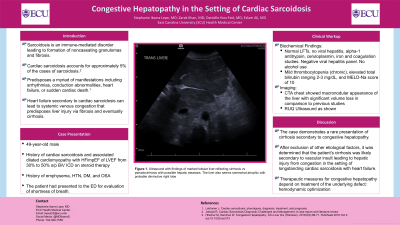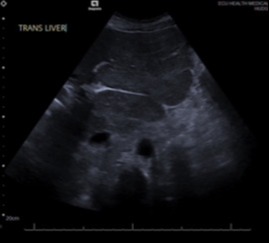Monday Poster Session
Category: Liver
P2571 - Congestive Hepatopathy in the Setting of Cardiac Sarcoidosis
Monday, October 23, 2023
10:30 AM - 4:15 PM PT
Location: Exhibit Hall

Has Audio

Stephanie Ibarra, MD
East Carolina University
Greenville, NC
Presenting Author(s)
Stephanie Ibarra, MD, Zarak Khan, MD, Danielle Hoo-Fatt, MD, Eslam Ali, MD
East Carolina University, Greenville, NC
Introduction: Sarcoidosis is an immune-mediated disorder leading to widespread inflammation caused by noncaseating granuloma formation and fibrosis. Its prevalence is highest in African American and Scandinavian populations. Cardiac sarcoidosis accounts for approximately 5% of the cases of sarcoidosis. It is caused by granuloma infiltration of the cardiac parenchyma, most commonly the myocardium. This predisposes a myriad of manifestations including arrhythmias, conduction abnormalities, heart failure, or sudden cardiac death. Cardiac dysfunction in the setting of heart failure can lead to systemic venous congestion that predisposes to liver injury with fibrosis and eventually cirrhosis.
Case Description/Methods: 49-year-old male with history of cardiac sarcoidosis and associated dilated cardiomyopathy with HFimpEF of LVEF from 30% to 50% s/p BiV ICD on steroid therapy, as well as history of emphysema, HTN, DM, and OSA presented with new findings of cirrhosis. The patient had presented to the ED for evaluation of shortness of breath. CTA chest obtained at the time was significant for macronodular appearance of the liver with significant volume loss in comparison to previous studies. The initial workup was unremarkable with normal LFTs, no viral hepatitis, normal alpha-1 antitrypsin level, normal coagulation studies, and no alcohol use. The only notable finding was a mild thrombocytopenia which was chronic in nature, elevated total bilirubin ranging 2-3 mg/dL, and MELD-Na score of 10. Otherwise there were no signs of decompensation. Further studies performed including RUQ ultrasound confirmed previous radiographic evidence of marked lobular liver findings. Additionally, ceruloplasmin, iron studies, and coagulation studies were diagnostically unremarkable. Thus, given the patient’s extensive history of heart failure in the setting of cardiac sarcoidosis, and after exclusion of other etiological factors, it was determined that the patient’s cirrhosis was likely secondary to vascular insult leading to hepatic injury from congestion.
Discussion: The case above demonstrates a rare presentation of cirrhosis secondary to congestive hepatopathy in the setting of longstanding cardiac sarcoidosis with heart failure. Although an ample array of differentials was considered, all these were eventually excluded. Ultimately, therapeutic measures for congestive hepatopathy depend on treatment of the underlying defect, in this case heart failure management via hemodynamic optimization.

Disclosures:
Stephanie Ibarra, MD, Zarak Khan, MD, Danielle Hoo-Fatt, MD, Eslam Ali, MD. P2571 - Congestive Hepatopathy in the Setting of Cardiac Sarcoidosis, ACG 2023 Annual Scientific Meeting Abstracts. Vancouver, BC, Canada: American College of Gastroenterology.
East Carolina University, Greenville, NC
Introduction: Sarcoidosis is an immune-mediated disorder leading to widespread inflammation caused by noncaseating granuloma formation and fibrosis. Its prevalence is highest in African American and Scandinavian populations. Cardiac sarcoidosis accounts for approximately 5% of the cases of sarcoidosis. It is caused by granuloma infiltration of the cardiac parenchyma, most commonly the myocardium. This predisposes a myriad of manifestations including arrhythmias, conduction abnormalities, heart failure, or sudden cardiac death. Cardiac dysfunction in the setting of heart failure can lead to systemic venous congestion that predisposes to liver injury with fibrosis and eventually cirrhosis.
Case Description/Methods: 49-year-old male with history of cardiac sarcoidosis and associated dilated cardiomyopathy with HFimpEF of LVEF from 30% to 50% s/p BiV ICD on steroid therapy, as well as history of emphysema, HTN, DM, and OSA presented with new findings of cirrhosis. The patient had presented to the ED for evaluation of shortness of breath. CTA chest obtained at the time was significant for macronodular appearance of the liver with significant volume loss in comparison to previous studies. The initial workup was unremarkable with normal LFTs, no viral hepatitis, normal alpha-1 antitrypsin level, normal coagulation studies, and no alcohol use. The only notable finding was a mild thrombocytopenia which was chronic in nature, elevated total bilirubin ranging 2-3 mg/dL, and MELD-Na score of 10. Otherwise there were no signs of decompensation. Further studies performed including RUQ ultrasound confirmed previous radiographic evidence of marked lobular liver findings. Additionally, ceruloplasmin, iron studies, and coagulation studies were diagnostically unremarkable. Thus, given the patient’s extensive history of heart failure in the setting of cardiac sarcoidosis, and after exclusion of other etiological factors, it was determined that the patient’s cirrhosis was likely secondary to vascular insult leading to hepatic injury from congestion.
Discussion: The case above demonstrates a rare presentation of cirrhosis secondary to congestive hepatopathy in the setting of longstanding cardiac sarcoidosis with heart failure. Although an ample array of differentials was considered, all these were eventually excluded. Ultimately, therapeutic measures for congestive hepatopathy depend on treatment of the underlying defect, in this case heart failure management via hemodynamic optimization.

Figure: Ultrasound with findings of marked lobular liver reflecting cirrhosis vs pseudocirrhosis with possible hepatic steatosis. The liver also seems somewhat atrophic with probable diminutive right lobe.
Disclosures:
Stephanie Ibarra indicated no relevant financial relationships.
Zarak Khan indicated no relevant financial relationships.
Danielle Hoo-Fatt indicated no relevant financial relationships.
Eslam Ali indicated no relevant financial relationships.
Stephanie Ibarra, MD, Zarak Khan, MD, Danielle Hoo-Fatt, MD, Eslam Ali, MD. P2571 - Congestive Hepatopathy in the Setting of Cardiac Sarcoidosis, ACG 2023 Annual Scientific Meeting Abstracts. Vancouver, BC, Canada: American College of Gastroenterology.
